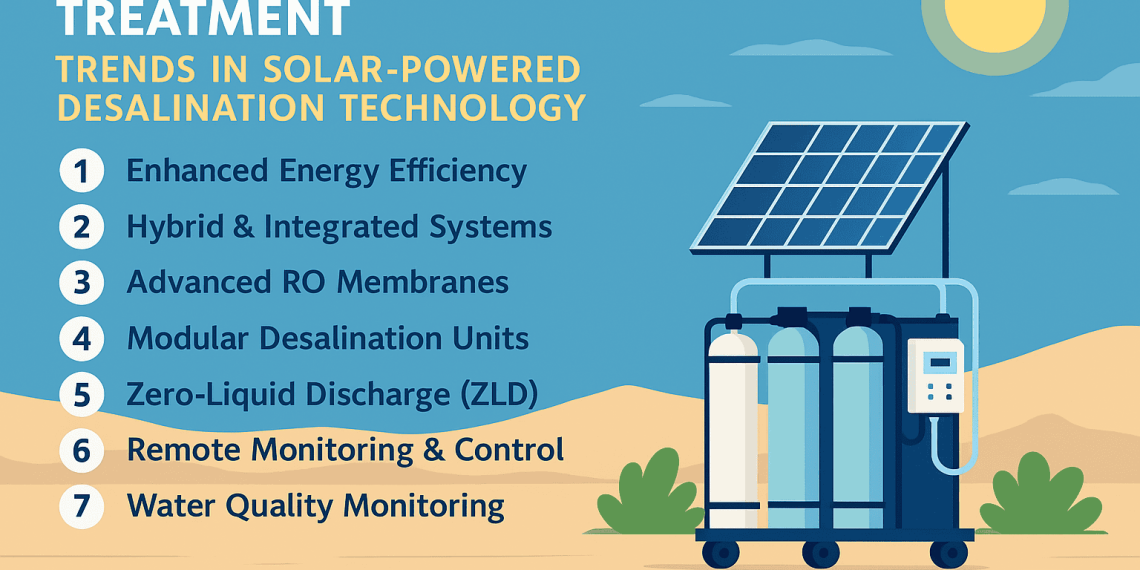Last updated on December 11th, 2025 at 06:11 pm
As climate change accelerates and freshwater sources dwindle, the demand for energy-efficient and scalable water purification solutions is reaching critical levels. Among the most promising innovations is solar-powered desalination — a clean, sustainable method that converts seawater or brackish water into potable water using the power of the sun.
In this blog, we’ll examine key trends, breakthroughs, and future projections that position solar RO desalination machines as a cornerstone in the global water treatment landscape.
1. Rise of Smart Solar Desalination Systems
The integration of smart controllers, IoT sensors, and real-time monitoring has revolutionized solar desalination systems. These technologies allow systems to:
- Automatically adjust flow and pressure based on sunlight availability
- Monitor Total Dissolved Solids (TDS) levels continuously
- Predict membrane replacement needs
- Send remote performance alerts
This reduces the need for on-site supervision while ensuring maximum uptime and efficiency.
Read: How Solar-Powered Desalination Machines Work: A Complete Guide for Sustainable Water Purification
2. Increased Focus on Modular and Mobile Units
The future is flexible and portable. Manufacturers like AMPAC USA are innovating modular, containerized RO systems that can be easily deployed in:
- Disaster response zones
- Remote military operations
- Island communities
These mobile solar RO units are compact yet scalable, making them ideal for temporary or emergency installations.
3. Integration with Battery Storage and Hybrid Energy
To counter fluctuations in solar radiation, advanced solar desalination machines are now being paired with battery banks and hybrid energy sources such as:
- Wind turbines
- Biofuel generators
- Grid-tied solar inverters
This ensures continuous operation during cloudy days or nighttime hours, eliminating downtime and improving reliability.
4. Sustainable Zero-Liquid Discharge (ZLD) Systems
Brine disposal remains a challenge in desalination. The latest trend focuses on zero-liquid discharge (ZLD) systems that:
- Recover nearly all water from input feed
- Minimize environmental impact
- Create salt by-products for commercial use
These solutions make solar desalination not only sustainable but also more environmentally responsible.
Read: Top Benefits of Using Solar RO Systems in Remote and Off-Grid Areas
5. Increasing Government and NGO Adoption
From the United Nations to local municipalities, public institutions are investing heavily in solar desalination. Key drivers include:
- Climate resilience programs
- Disaster preparedness initiatives
- SDG (Sustainable Development Goals) compliance
Countries in Africa, Southeast Asia, and the Middle East are leading adopters, often in collaboration with NGOs and water tech companies.
6. Customization Based on Geographic and Water Quality Factors
Future-ready systems will not be one-size-fits-all. Instead, site-specific customization is becoming a norm:
- High-salinity designs for coastal regions
- Arid region adaptations with higher efficiency membranes
- Pre-treatment modules based on feedwater contaminants
This ensures maximum purification efficiency and longer system lifespan.
7. Growing Role of AMPAC USA in Next-Gen Desalination
With over three decades of innovation, AMPAC USA continues to lead in the design of solar seawater desalination machines that align with these future trends. Their systems are built for:
- Long-term durability
- Plug-and-play deployment
- Extreme environmental conditions
- Low-maintenance performance
Whether you’re a government agency, NGO, or private operator, AMPAC USA has a future-forward solution.
Discover our next-gen Solar Watermaker Systems designed for tomorrow’s challenges.
Final Thought: The Future is Solar
As water becomes the new gold, solar desalination offers a powerful, planet-friendly solution. Future desalination systems will be:
- Smarter
- Faster
- Cleaner
- More accessible
The shift is already underway — and companies like AMPAC USA are at the forefront of this clean water revolution.











